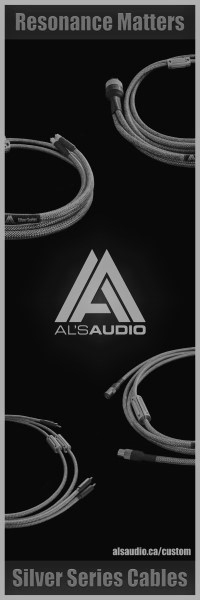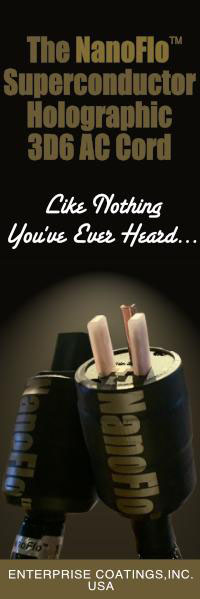Sunfire True Subwoofer Mark II
| Sunfire True Subwoofer Mark II |
|
Martin Appel |
|
2 January 2002 |
 Specifications
Specifications
2700-watt amp featuring patented Tracking Downconverter power supply.
Input coupling is optical: accepts standard and high-level inputs.
Bore 8 inches – stroke 2.35 inches.
Total air volume displacement is over 235 cubic inches.
Crossover points: variable from 35 Hz to 100 Hz.
Crossover slope: 36 dB/octave.
Input level (volume) control
Phase continuously adjustable 0 to 180 degrees.
Frequency response: 18 Hz to 100 Hz (plus 0-3 dB).
Passive 70 Hz 6 dB per octave hi-pass line level output for Satellite loudspeakers
Warranty: Two-years
Dimensions: 11″ × 11″ × 11″
Weight: 48 lbs.
Price $1,495 U.S.
Subwoofers are an interesting lot and require some understanding in order to take full advantage of what a good one can do. After years of listening, and going through many system upgrades, it was apparent that I was missing that last octave of bass from my system. All along I had been rationalizing that most music didn’t occur there and that 32Hz was good enough in my 16′ × 20′ living room. Along the way, I’d reviewed the InnerSound Isis hybrid ESL speaker (10/99) and I learned that the adjustment of bass settings had a terrific impact on the openness and clarity in the midrange of the speaker. Along with this awareness and knowledge, and various audiophile buds constructive comments (Clement Perry and Mike Levy, to name a few), I decided that a subwoofer might just do the trick since I was quite pleased with all other aspects of the sound of my system.
During my investigations I had the pleasure of reviewing the Sunfire Theater Grand Processor II (11/2000) and was so impressed with it that it found a permanent home in my system. When I told Randy Bingham at Sunfire that I was interested in a subwoofer for my 2-channel music system, he suggested trying their products and seeing which would be most appropriate in my system. Suffice it to say I then spent several months trying different models: the Architectural Signature, True Subwoofer Signature and the True Subwoofer Mark II. All the products had excellent virtues and were of different sizes and configurations, but these ears preferred the Mark II. I know that there have been several reviews already written in the audiophile press about this subwoofer, but I still felt that a fresh look would be worthwhile.
Let me back up a minute. What does one want in a subwoofer? I think speed, impact and extension are the most critical factors. Having good extension without speed makes for indistinct sound that muddies the presentation. We want our woofers to start and stop as quickly as possible, and the push-pull design of the Mark II accomplishes this very well. Having the great power reserves the self-contained amp has creates enormous impact and adds to the control of the woofer. Its low end extension is very impressive and if one wants to have a lease breaking party, just turn up the volume on this littler monster and the landlord will be knocking on your door!
Speaking of controls, the Mark II has continuously variable volume, phase and crossover controls that are very easy to use and very necessary if one is to optimize the sound of one’s system. The manual is instructive and is critical to make the fine-tuning adjustments once you’ve established room placement. It is also critical, as indicated in the manual, not to plug in the Mark II in the same outlet as the rest of your system for there is good possibility that a ground loop creating hum will occur. With a sub-woofer this powerful it is easy to be seduced by its power and impact to the detriment of a natural musical presentation. One should take extra care to maintain a natural balance by using the controls, especially the crossover and volume, to seamlessly integrate the sub into your system. The sub should be felt, not heard. Having another person at the controls at the subwoofer while you’re sitting in your listening spot spinning some of your reference CD’s is the easiest and quickest way to establish the best settings for your subwoofer to achieve optimal sonic integration with your speakers. If no friends are available, be prepared for a lot of getting up and down from your favorite listening position while you evaluate each adjustment.
Set up
I found that using a position of three feet away from the side wall and about eight inches away from the rear wall worked best for me. Since my speaker’s bottom end is about 32 Hz, I found that for the smoothest transition, a setting of approximately 40Hz worked best. This prevented the subwoofer from making you aware of its presence. The reason I say approximately 40 Hz is that the control is continuously variable form 35 to 100 Hz without any click stops but with a “Normal” indication at 65 Hz. Let your ears guide you. Similarly, I found the volume control, which starts at “min.” and ends at “+15db”, with an intermediate setting of “0db” to work best barely turning it about 10% past the “min.” setting. The phase control setting I ended up with was the “Normal” setting or 90 degrees, halfway between the “0db” and “180db” settings. There is an alternate method using an SPL meter and a “Stereophile” test disc described in the manual, but I chose to use my ears for final set up. The manual suggests the use of the included rubber feet to prevent the sub from “walking.” I found this wasn’t necessary since my floor is carpeted. I could certainly see it being useful to someone who has smooth flooring who really likes cranking up the bass on this little monster. By the way, when installed, it is always on in a standby mode and when an audio signal is sensed at the input it goes active with a perceptible thump. Not objectionable to me but some might not like this.
After setting up the subwoofer to my liking I have to say it made a startling improvement to bass weight, definition and impact. That shouldn’t have been a surprise, but nevertheless it was excellent. What was equally satisfying was the improvement it made to the overall openness of the sound, both broadening and deepening the soundstage and opening up the midrange. It seemed to add more air and life to the presentation. It seemed no matter what I played, these improvements were consistently there. How did I ever do without the Sunfire Mark II? Listening to the RCA Living Stereo CD, Stokowski: Rhapsodies [RCA 09026-61503-2], cut 1, Liszt’sHungarian Rhapsody No. 2 in C- Sharp Minor, one of my favorite recordings, proved to be a revelation. The deep growl produced by massed double bass and cello was startling with their impact and were articulated like never before. Another example is Verve’s, Parker’s Mood, with Roy Hargrove on trumpet, Christian McBride on bass and Stephen Scott on Piano. On cut after cut, McBride’s bass was so “there,” with speed, articulation and impact, that one could virtually see and feel his fingers patrolling the strings. When he used the bow, that resinous quality could be felt and the full tonality of the instrument was extraordinary.
Needless to say I spent many hours re-listening to much of my music collection. I rediscovered that excitement we are occasionally lucky enough to experience when something right happens that makes our search for the recreation of live music in our listening rooms take a step closer to reality. The fact that this all comes in a tidy 11 inch cube makes it even more inviting. Once this little monster is let out of its cage there’s no going back.
The True Subwoofer Mark II now resides in my home as an integral part of my reference system
Observation and comment
The day after writing this review I had the great pleasure of seeing the Julliard Orchestra perform at live at Lincoln Center from the vantage point of seventh-row center orchestra seats. Those of you who only spend time comparing systems and components should give yourself such a treat. We all need a reality check. After all, isn’t this the ultimate reference we are all striving to recreate? Those of you who think that you can never get enough detail are correct. And those of you who think you can’t get enough accuracy are also correct. For these characteristics are what “musicality” is by definition. After all, the more accurate our systems are, the closer we come to the goal of achieving the musical reality we all seek. Not once during the performance did I wish that the strings were softer or warmer or that the trumpets were sweeter or wonder if the sound stage was deep enough. Audiophile words like lush, sweet, and smooth didn’t exist. Let’s not kid ourselves, we all have a long way to go to achieve what one experiences in that orchestra seat from our home music recreation systems. We can only hope to keep improving and aiming for that live sound that is music.
Keep Listening.
![]()
Don’t forget to bookmark us! (CTRL-SHFT-D)
Stereo Times Masthead
Publisher/Founder
Clement Perry
Editor
Dave Thomas
Senior Editors
Frank Alles, Mike Girardi, John Hoffman, Russell Lichter, Terry London, Moreno Mitchell, Paul Szabady, Bill Wells, Mike Wright, Stephen Yan, and Rob Dockery
Current Contributors
David Abramson, Tim Barrall, Dave Allison, Ron Cook, Lewis Dardick, Dan Secula, Don Shaulis, Greg Simmons, Eric Teh, Greg Voth, Richard Willie, Ed Van Winkle, and Rob Dockery
Music Reviewers:
Carlos Sanchez, John Jonczyk, John Sprung and Russell Lichter
Site Management Clement Perry
Ad Designer: Martin Perry





Be the first to comment on: Sunfire True Subwoofer Mark II